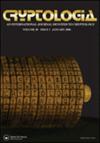关于里尔克密码的论文
IF 0.4
4区 工程技术
Q4 COMPUTER SCIENCE, THEORY & METHODS
引用次数: 1
摘要
摘要“里尔克密码”可能是源自二战的德国密码。本研究总结了文本的历史,并考察了对其性质的解释。将统计技术应用于更新的转录。该文本由3305个独特的四人组中的18760个字符组成,在一本普通的书的33页上排列成670行7列。这些组的分布并不是特别的Zipfian,这表明文本可能不是一个代码或单字母替换密码。它的字母表比英语和德语长(46个字符)。字符和N-gram熵分析表明,文本的有序性不如英语和德语,但比随机文本更有序。机器学习模型表明文本是一个替代密码,但频率和Kasiski Kerckhoff分析表明情况并非如此。Sukhotin对文本的算法结果与德语的结果有些一致,尽管N-gram分布与英语或德语并不十分相似。对物理打字机键距的统计分析表明,文本的分组极不可能随机出现,并且与有意的“懒惰”打字一致。该文本与其时代的机器密码(例如Enigma)不一致,其他特征也与非密码解释不完全一致。需要进一步调查。本文章由计算机程序翻译,如有差异,请以英文原文为准。
A treatise on the Rilke cryptogram
Abstract The ‘Rilke Cryptogram’ is a possible cipher of German, WWII origin. This study summarises the text’s history, and examines explanations for its nature. Statistical techniques are applied to an updated transcription. The text consists of 18,760 characters in 3,305 unique groups of four, arranged into 670 rows by seven columns on 33 pages of an otherwise ordinary book. The distribution of these groups is not particularly Zipfian, suggesting the text is likely not a code or monoalphabetic substitution cipher. Its alphabet is longer than English and German (46 characters). Character and N-gram entropy analyses suggest the text is less ordered than English and German, but more ordered than random text. Machine-learning modelling suggests the text is a substitution cipher, but frequency and Kasiski-Kerckhoff analyses suggest otherwise. Sukhotin’s algorithm results for the text are somewhat consistent with results for German, though N-gram distributions do not strongly resemble English or German. Statistical analysis of physical typewriter key distances suggest the text’s groupings are highly unlikely to appear at random, and are consistent with intentional ‘lazy’ typing. The text is inconsistent with machine ciphers of its era (e.g., Enigma), and other features are not entirely consistent with non-cipher explanations. Further investigation is required.
求助全文
通过发布文献求助,成功后即可免费获取论文全文。
去求助
来源期刊

Cryptologia
工程技术-计算机:理论方法
自引率
33.30%
发文量
31
审稿时长
24 months
期刊介绍:
Cryptologia is the only scholarly journal in the world dealing with the history, the technology, and the effect of the most important form of intelligence in the world today - communications intelligence. It fosters the study of all aspects of cryptology -- technical as well as historical and cultural. The journal"s articles have broken many new paths in intelligence history. They have told for the first time how a special agency prepared information from codebreaking for President Roosevelt, have described the ciphers of Lewis Carroll, revealed details of Hermann Goering"s wiretapping agency, published memoirs - written for it -- of some World War II American codebreakers, disclosed how American codebreaking affected the structure of the United Nations.
 求助内容:
求助内容: 应助结果提醒方式:
应助结果提醒方式:


